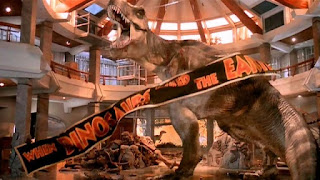As the dinosaur blockbuster celebrates
its 25th birthday, we look back at the impression it made on its
release in 1993, and the impossible benchmark it raised for future filmmaking.
It might not amount to a blink in Earth’s history, but 25 years is still a long time – and it’s been that long since Steven Spielberg’s Jurassic Park landed with a heavy, ground-shattering stomp and a screen-splitting roar. Based on the late Michael Crichton’s bestselling novel of the same name, it sees a group of scientists pitted against genetically-engineered dinosaurs when they break free from their enclosures in a remote Costa Rican theme park. The film was met with both financial and critical praise on its release, largely for its seamlessly-interwoven use of the jaw-dropping practical and digital effects - courtesy of ILM (Industrial Light and Magic) and the late Stan Winston - that would dramatically change the course of cinematic history.
Something you can see and touch
But it
wasn’t just a film that inspired intrigue among audiences - it ignited the
debate as to whether scientists could (even if they weren’t to stop and think
if they should) clone prehistoric animals using fossilised DNA. Like 1989’s Back to the Future II, the film had
seemingly set a real-world scientific challenge, though one far more
ethically-questionable than self-tying shoes and hover-boards. In reality,
though, ILM’s creations are probably the closest we’ll ever get to seeing real
dinosaurs, but it was this topic that led to the film being labelled as
“science eventuality” rather than “science fiction” at the time, thus inviting
more curiosity and accentuating the ever-appealing “what if” factor of the
common sci-fi.
Science fiction or science fact?
However,
it’s the film’s importance in cinema that cannot be overstated, having been the
first one to use CGI in complex ways, bringing to life – or perhaps recreating
– long-time extinct animals. Today, even the film’s animatronic dinosaurs
remain no less impressive and frighteningly-real. And that’s just the flesh to
the bones of Spielberg’s masterpiece. Not only does the film intelligently
combine suspense and terror, along with humour and some of those charming
Spielbergian undertones, it uses only 15 minutes of dinosaur screen-time to do
so. The result is an atmosphere that’s both incomparable and as dense as the
jungle from which the film’s scaly villains emerge.
Objects in picture are smaller than they appear
Perhaps,
though, and beyond the fact that it’s actually a hybrid of not one, but two original concepts (a dinosaur-inhabited
safari park and the genetics-based
resurrection of dinosaurs) it’s the film’s true sense of wonder that rendered
it an instant classic. Never before had audiences seen such convincing
dinosaurs – or any animal, for that matter - onscreen, let alone been
completely terrified by them at the same time.
Do you remember the first time you saw a dinosaur?
Its cast –
then mostly unknown with the exception of late veteran actor Lord Richard
Attenborough and the charisma-spewing Jeff Goldblum – were brilliant, and are
now as iconic as the film’s prehistoric characters. But it was the talents of
child actors Ariana Richards and Joseph Mazzello, who played siblings Lex and
Tim Murphy, respectively, that helped make Jurassic
Park a film that would terrify children the world over in the same way
Spielberg’s Jaws terrified an entire
generation of swimmers; immersing the younger audience members into the
backseats of a car that’s under siege from a twenty-foot T.Rex during a
thunderstorm, and onto the cold hard floor of a dark open kitchen where
menacing raptors lurk.
The film's protagonist made quite the impact
Following Jurassic Park’s success, to no surprise
it went on to spawn its own film series, with the fifth entry Jurassic World: Fallen Kingdom due for
release in June 2018. But its sequels never quite made the same impact, at
least not critically. Spielberg’s The
Lost World: Jurassic Park (1997) -
based on Crichton’s critically-acclaimed follow-up novel The Lost World - captured the atmosphere of the original, but
failed, in part at least, to make audiences go “ooh” and “aah”, even when the
running and screaming started. And its hugely-dissatisfying 2001 successor Jurassic Park III, directed by Joe
Johnston, marked the beginning of a 14-year hiatus for the franchise, seemingly
rendering it extinct at the time.
Jurassic Park III failed to impress
However, the
long-awaited, nostalgia-powered Jurassic
World, directed by Colin Trevorrow, breathed new life into the fossilised
franchise and even hungrily devoured a meaty $1.6bn during its global cinematic
rampage. Even if the film itself is arguably a clone of the original, Trevorrow
had ingeniously rebranded the franchise, slapped it back on the same plastic
lunchbox, and re-sold it. And while it’s unlikely this year’s Jurassic World: Fallen Kingdom will
break new ground (although there is an earthquake in the film), it will no
doubt make as big a dent in the box office as its predecessor. After all, the
Jurassic Park brand – even if it’s now more commonly known as “Jurassic World”
- is stronger than it’s ever been.
Jurassic World took a big bite out of the box office
The fact
that a fifth film upon us, though, is remarkable. It seems only like yesterday
that the original sent vibrations through pop drinks in theatres worldwide. But
that’s because of its truly timeless storytelling and special effects that,
even to date, show no signs of fossilisation. It also helps that its iconic
characters and lines have been immortalised in countless forms of media and
merchandise. So it’s fair to say that the life of Jurassic Park really did “find a way”, because no matter what
catastrophes may come in the form of sequels, it will never go extinct.
Life finds a way
J.A.
Bayona’s Jurassic World: Fallen Kingdom
stars Chris Pratt, Bryce Dallas Howard and will see the return of Jeff
Goldblum. It hits theatres in the UK on June 6 and in the U.S. on June 22.









No comments:
Post a Comment